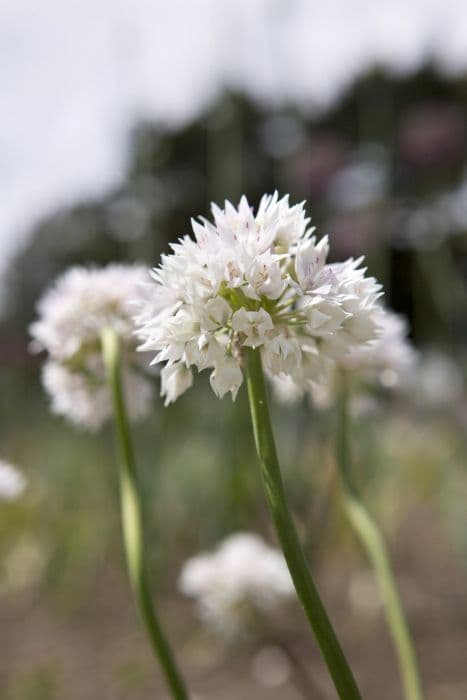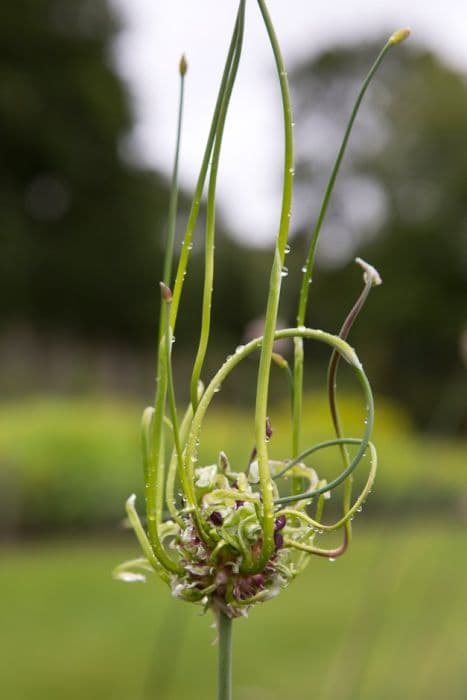Keeled garlic Allium carinatum subsp. pulchellum

ABOUT
The plant known as keeled garlic is a perennial herbaceous plant that presents a striking appearance in gardens or wild landscapes. Its foliage consists of slim, strap-like leaves that are green in color and have a glossy texture. During the blooming season, it showcases eye-catching flower clusters, which are typically arranged in an umbrella-like shape called an umbel. The flowers themselves are usually a soft pink or occasionally white, and are star-shaped, featuring delicate petals that splay outwards attractively. Each petal is marked with a prominent central vein, giving the flowers a textured appearance. Adding interest, the umbel may also host bulbils, which are small bulb-like structures that can propagate the plant. The overall aesthetic of the keeled garlic is one of a fine, intricate structure that adds a touch of whimsy to its setting, making it a favorite among gardeners who appreciate its unique and decorative flowers.
About this plant
 Names
NamesFamily
Amaryllidaceae
Synonyms
Keeled Garlic, Ornamental Onion, Beautiful Allium
Common names
Allium carinatum var. pulchellum, Allium pulchellum, Allium stenophyllum.
 Toxicity
ToxicityTo humans
Allium carinatum subsp. pulchellum, commonly known as Keeled Garlic, is not considered toxic to humans. As with other members of the Allium family, it is edible and is sometimes used in cooking for its flavor. However, it is important to note that consumption of large quantities of Allium species can lead to gastrointestinal irritation or discomfort in some individuals, but this is generally rare and not severe.
To pets
Keeled Garlic is toxic to pets, especially cats and dogs. Similar to other members of the Allium genus (which includes onions, garlic, chives, and leeks), consuming Keeled Garlic can cause oxidative damage to red blood cells leading to hemolytic anemia. Symptoms of poisoning in pets may include vomiting, diarrhea, abdominal pain, lethargy, and pale gums. In severe cases, ingestion can lead to respiratory problems, organ damage, or even death if left untreated. It is important to keep this plant out of reach of pets and to seek veterinary assistance immediately if ingestion is suspected.
 Characteristics
CharacteristicsLife cycle
Perennials
Foliage type
Deciduous
Color of leaves
Green
Flower color
Pink
Height
1-2 feet (30-60 cm)
Spread
0-1 foot (0-30 cm)
Plant type
Bulb
Hardiness zones
5
Native area
Europe
Benefits
 General Benefits
General Benefits- Aesthetic Appeal: Allium carinatum subsp. pulchellum, commonly known as Keeled Garlic, offers ornamental value with its distinctive, attractive flowers that can enhance the visual appeal of gardens and landscapes.
- Pollinator Attraction: The flowers of Keeled Garlic attract a variety of pollinators, including bees and butterflies, which are vital for the pollination of many plants and the overall health of ecosystems.
- Drought Resistance: Keeled Garlic is known for its ability to tolerate dry conditions once established, making it suitable for xeriscaping and water-wise gardening.
- Low Maintenance: This plant typically requires minimal upkeep, thriving in a variety of soil conditions and withstanding neglect better than many ornamental plants.
- Culinary Use: The leaves and bulbs of Keeled Garlic are edible and can be used in cooking, imparting a mild garlic flavor to dishes.
- Companion Planting: Keeled Garlic can be grown alongside other plants to create diversity in the garden, which can help reduce the spread of pests and diseases.
- Attractive Seed Heads: After flowering, Keeled Garlic produces attractive seed heads that add textural interest to the garden and can be used in dried flower arrangements.
 Medical Properties
Medical PropertiesThis plant is not used for medical purposes.
 Air-purifying Qualities
Air-purifying QualitiesThis plant is not specifically known for air purifying qualities.
 Other Uses
Other Uses- Allium carinatum subsp. pulchellum, or keeled garlic, can be used in floral arrangements for its attractive blossom umbels and lasting quality.
- The plant's striking inflorescence makes it suitable as a natural outdoor ornament, especially in rock gardens.
- The seeds of keeled garlic can be sown to create ground cover in areas where other plants struggle to flourish.
- Due to its unique flower shape and color, keeled garlic is great for adding visual diversity to pollinator-friendly gardens attracting bees and butterflies.
- Keeled garlic can be used in educational settings, such as school gardens, to help teach students about plant life cycles and biodiversity.
- The plant can serve as a companion plant in vegetable gardens, as its scent is thought to deter certain pests.
- Gardeners may use the tall, erect stems of keeled garlic for supporting or adding structure to more delicate plants nearby.
- The dried flowers can be used in crafts such as homemade potpourri due to their unique shape and seed pods.
- Keeled garlic can be integrated into a xeriscape garden design, which requires minimal irrigation and maintenance.
- As a photography subject, the intricate flowers can provide a beautiful natural element in close-up shots for plant enthusiasts and photographers.
Interesting Facts
 Feng Shui
Feng ShuiThe plant Allium carinatum subsp. pulchellum, commonly known as Knapweed Star-of-Persia, is not used in Feng Shui practice.
 Zodiac Sign Compitability
Zodiac Sign CompitabilityThe plant Knapweed Star-of-Persia is not used in astrology practice.
 Plant Symbolism
Plant Symbolism- Unity: Alliums, also known as ornamental onions, often have round, globe-like flowers that symbolize unity and togetherness, suggesting that every individual floret is part of a larger, integrated whole.
- Patience: The Allium carinatum subsp. pulchellum, or the 'Keeled Garlic', takes time to develop its striking bloom, which can be seen as a representation of patience and the reward of waiting.
- Strength: As a member of the onion family, this plant displays resilience and durability, making it emblematic of strength and endurance.
- Prosperity: Historically, many alliums were regarded as symbols of prosperity and abundance due to their culinary uses and the belief that their strong scent could ward off evil spirits.
- Good Fortune: In some cultures, allium flowers are considered to bring good luck, which may extend to the Keeled Garlic as it shares the characteristic features of the family.
 Water
WaterOrnamental onion should be watered thoroughly, allowing the soil to dry out slightly between waterings. Typically, it needs about 1 inch of water per week, either from rainfall or supplemental watering. During the active growing season in spring and summer, ensure consistent moisture but avoid overwatering which can lead to bulb rot. In fall and winter, reduce watering as the plant goes dormant. You can water with approximately half a gallon every week for smaller groupings, adjusting based on weather conditions and soil drainage.
 Light
LightOrnamental onion thrives in full sun exposure, requiring at least 6 hours of direct sunlight daily to develop strong stems and vibrant blooms. The ideal spot for this plant is in a garden bed or border that receives unfiltered sunlight throughout the day. Light shade is tolerable, especially in hotter climates, but too much shade can lead to weak growth and fewer flowers.
 Temperature
TemperatureOrnamental onion prefers temperate climates, with ideal growing temperatures between 55°F and 75°F. It is cold-hardy and can survive winter temperatures down to around 20°F, making it suitable for USDA zones 4 through 8. The plant can also tolerate high temperatures up to around 90°F, however, it may need additional water to cope with the heat.
 Pruning
PruningOrnamental onion requires minimal pruning. Deadheading spent flowers can promote a tidier appearance and sometimes encourage a second, though smaller, bloom. In late fall, once the foliage has yellowed and died back, you can cut the plant back to ground level. Pruning is typically done once a year after flowering and dormancy cues.
 Cleaning
CleaningAs needed
 Soil
SoilKnapweed allium thrives in a well-drained, sandy loam soil mix with a pH of around 6.0 to 7.5. To create the ideal soil mix, combine two parts garden soil, one part sand, and one part compost to ensure good drainage and fertility. Regularly check the pH to maintain the optimal conditions for the plant's growth.
 Repotting
RepottingKnapweed allium generally doesn't require frequent repotting and can be repotted every 3-4 years. It's best to repot in the fall after the foliage has died back, or in early spring before new growth begins. Ensure proper drainage in the new pot to avoid root rot.
 Humidity & Misting
Humidity & MistingKnapweed allium prefers average outdoor humidity levels but can tolerate a range of conditions. It does not have specific humidity requirements, making it versatile and adaptable to most climates. Excessive humidity can lead to fungal issues, so ensure good air circulation if grown in more humid environments.
 Suitable locations
Suitable locationsIndoor
Place knapweed allium in a sunny window, in well-draining soil.
Outdoor
Plant knapweed allium in sun, well-draining soil; water sparingly.
Hardiness zone
4-8 USDA
 Life cycle
Life cycleAllium carinatum subsp. pulchellum, commonly known as the Keeled Garlic, begins its life cycle as a seed, which, when sown in well-drained soil and given adequate sunlight and water, will germinate and sprout. The sprout develops into a young plant with a bulb at its base and thin, grass-like leaves. As it matures, the bulb enlarges, storing energy for next season's growth. The plant reaches maturity and produces tall flower stalks topped with umbels of small, typically pink or purple, star-shaped flowers during the summer months. After pollination, usually by bees or other insects, the flowers develop into seed capsules which eventually release seeds to complete the reproductive cycle. In autumn, the plant's foliage dies back, and the bulb goes into dormancy during the colder winter months, re-emerging in the spring to begin the cycle anew.
 Propogation
PropogationPropogation time
Spring-Early Summer
Allium carinatum subsp. pulchellum, commonly known as Keeled Garlic, is best propagated by dividing the bulbs. This propagation method is most effectively done in the fall after the foliage has died back. Gardeners should gently lift the clump of bulbs out of the soil using a spade or fork, taking care not to damage the bulbs. Once lifted, the clump can be gently separated into individual bulbs. Each bulb can then be replanted immediately at a depth of about 3 inches (approximately 7.6 centimeters) and spaced approximately 4 to 6 inches apart (10 to 15 centimeters). The newly planted bulbs will establish themselves over the winter and begin growth in the spring. This method ensures genetic consistency and is a simple and reliable way to increase your stock of Keeled Garlic.








